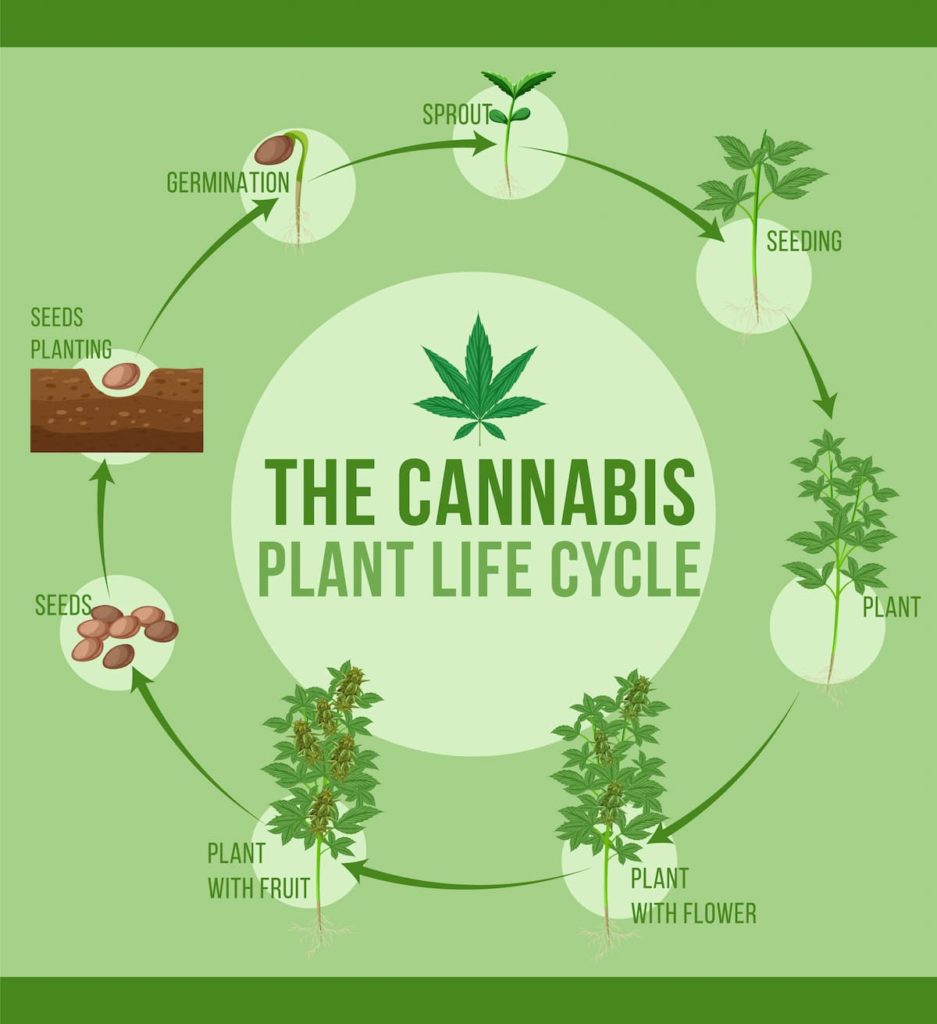Cannabis cultivation has ancient roots, with evidence suggesting its use and growth over thousands of years across different cultures. Today, as the plant gains more legal and societal acceptance, understanding its growth patterns becomes even more crucial. One frequently asked question is, “Do cannabis plants grow at night?” Let’s delve deeper into this and other fascinating aspects of cannabis cultivation.
Understanding the Cannabis Growth Cycle
Every living organism has its rhythm, and plants are no exception. Cannabis plants follow a circadian rhythm, a natural 24-hour cycle that dictates their sleep-wake patterns. This rhythm plays a pivotal role, especially when differentiating between the vegetative and flowering stages of cannabis. The Growth cycle itself can be broken down as follows.

Growth Stages of Cannabis:
- Germination (3-10 days): This is the initial stage where the seed begins to sprout.
- Seedling (2-3 weeks): The plant starts to develop its first set of leaves.
- Vegetative (3-16 weeks): The plant focuses on growing in size and stature. It’s during this phase that the plant requires the most light, typically around 18-24 hours.
- Flowering (7-12 weeks): The plant starts producing buds. It’s also the phase where the light cycle is reduced, typically to 12 hours of light and 12 hours of darkness.
Day vs. Night: What Happens?
During the sunlit hours, cannabis plants are busy performing photosynthesis. This process allows them to convert light into energy, essential for their survival and growth. But as the sun sets, the plants don’t just “sleep.” They switch to respiration mode, focusing on growth and cell repair. This nighttime activity is crucial for their overall health and development, especially during the flowering phase.
The Science of Night Growth
While it might seem counterintuitive, most of the cell division in cannabis plants occurs during the night. The energy produced during the day through photosynthesis is stored and then utilized for growth when darkness falls. Additionally, the roots, the lifeline of the plant, also tend to grow more during the night. A robust root system ensures that the plant gets all the nutrients it needs, leading to a healthier and more bountiful yield.
Recovery from Daily Stress
Just like humans, cannabis plants face a myriad of daily stresses, each posing its own set of challenges:
- Intense Midday Sun: Prolonged exposure to the harsh midday sun can cause the leaves to wilt or even get sunburned. This can reduce the plant’s ability to photosynthesize efficiently.
- Strong Winds: While a gentle breeze can strengthen the stems, strong winds can break branches, damage leaves, or even uproot young plants.
- Pests and Insects: Aphids, spider mites, and whiteflies are just a few of the pests that can infest cannabis plants. They can damage the plant by sucking out its sap, leading to yellowing leaves and reduced growth.
- Overwatering or Underwatering: Both can be detrimental. Overwatering can lead to root rot, while under-watering can cause the plant to become dehydrated and stunt its growth.
- Fluctuations in Temperature: Sudden temperature drops or spikes can stress the plant. Cannabis prefers a consistent temperature, and fluctuations can slow down growth or even damage the plant.
- Nutrient Imbalances: Providing too much or too little of certain nutrients can lead to nutrient burn or deficiency. This can manifest as discoloration of leaves, stunted growth, or even reduced bud production.
- Diseases: Fungal infections like powdery mildew or root rot can severely affect the health of the plant, leading to reduced yield or even plant death.
Nighttime offers cannabis plants a much-needed respite from these stresses. It’s a chance to recover, heal, and rejuvenate, preparing them for the challenges of the next day. By understanding these daily challenges, growers can take proactive measures to ensure their plants remain healthy and robust.
The Role of Darkness in Flowering
Darkness isn’t just a time for rest and growth; it plays a pivotal role in the flowering of cannabis plants. In the absence of light, plants produce a hormone called “florigen.” This hormone is instrumental in the flowering process. For cannabis plants, especially those in the flowering stage, an uninterrupted dark phase is paramount to a good grow.
Practical Tips for Growers
For those cultivating cannabis, understanding its nighttime needs is essential. Here are some tips:
- Maintain a Strict Light Schedule: It’s crucial to ensure that the plants get the darkness they need. Adhering to a consistent light schedule can make a significant difference in the growth and health of your cannabis plants. For more on indoor growing, learn about the importance of using a carbon filter to maintain a clean and odour-free environment.
- Monitor Plant Health Regularly: Especially during nighttime, it’s vital to keep an eye out for signs of stress or disease. Regular checks can help you detect issues early and take corrective measures. Enhance your indoor gardening experience by understanding the advantages of LED grow lights.
- Create an Optimal Environment: Ensuring the right temperature and humidity levels is key for night growth. If you’re considering different growing mediums, explore the benefits of growing cannabis in coco coir.
For those looking to further enhance their cannabis cultivation skills, delve into these additional resources:
- Discover tips to improve the quality of your cannabis buds.
- Learn about the different training techniques used by expert cannabis growers to maximize yield and potency.
Common Myths About Cannabis Growth:
- Growing Weed is Expensive: While it can be costly, especially with professional equipment, it doesn’t have to be. Efficient and budget-friendly methods are available for cultivators.
- Good Strain Genetics Guarantee High Potency: Genetics play a role, but growing conditions, care, and other factors also influence potency.
- More Nutrients, The Better: Overfeeding can harm cannabis plants. It’s about balance and understanding the plant’s needs.
- Outdoor Growing Conditions Can’t Produce Top-Shelf Cannabis: Quality cannabis can be grown both indoors and outdoors.
- Drying Plants Upside Down Boosts Potency: While hanging cannabis upside down is recommended during the drying phase, it doesn’t necessarily boost THC levels.
In summary, the nighttime growth of cannabis plants is a topic of immense importance. As we’ve discovered, the dark hours are bustling with activity, from cell division to root growth. For growers, recognising and catering to these nighttime needs can make all the difference in yield and quality. So, the next time you gaze at your cannabis plants under the moonlight, know that they’re hard at work, growing and thriving.
